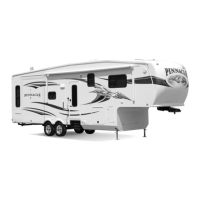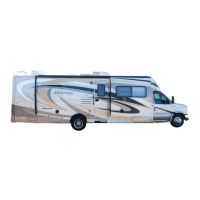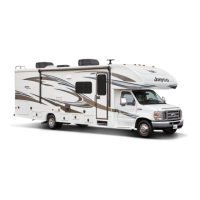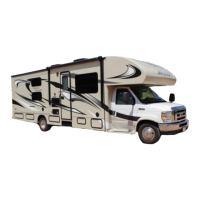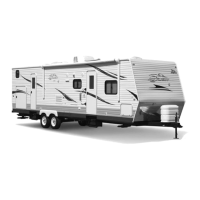SECTION 4
TOWING & HANDLING
Vehicle Clearance
Remember some bridges, older ones in
particular, may not support the weight of your
RV. Know the weight and size of your towing
combination and observe any posted weight
and clearance limits. The added height of roof
air conditioners, TV antennas or floodlights
may cause clearance problems around some
tunnels, canopies and hanging signs.
Turning Corners
When turning, the rear tires may not always
follow the path of your front tires. You must
compensate for this action by carefully pulling
the RV out into the intersection further than
you would normally so that the RV clears the
curb (or any parked vehicles along the curb).
When making a turn, check the road
clearance and be aware of others. Have
someone help guide you out of a difficult
parking space or traffic pattern. Swerves and
sharp turns, especially at high speeds, could
result in loss of control of the RV.
Backing up
If your camping destination does not have pull
through sites, pick a level site and back in
carefully. We suggest you stop near the site,
get out of the RV and observe the
surrounding area. Check to ensure there are
no obstacles in your path and that you have
plenty of vehicle clearance. Check for low-
hanging tree limbs, posts, large rocks or other
obstacles. Try to choose a site that is on the
driver’s side, so you can see what the rear of
the RV is doing. With the site on the
passenger side, you would be backing into
the site on your blind side, which is more
difficult. When you determine the site
conditions are satisfactory, maneuver the RV
into position for backing up into the site
space. Back the RV up slowly using your
mirrors and rear view camera as a guide.
Have another person outside the RV assist
you until the RV is parked in the desired
position.
Parking
After the RV is in the desired location, set the
parking brake and place the transmission in
park. Turn OFF the ignition switch. Go outside
the RV and block all wheels securely with
wheel chocks. The wheel chocks can be
wood blocks or purchased items as long as
they prevent the RV from rolling. Be aware of
your surroundings. If parking at night at a rest
stop, truck stop or parking lot chose a well-
lighted area.
FRONT AXLE TIRE ALIGNMENT
The term alignment refers to both the
adjustment angles on the steering axle and
suspension and tracking of the rear axle.
Many factors are considered when
establishing proper alignment. Steering
components, suspension, wheel bearings and
even proper loading will affect the alignment.
We recommend you have the front
suspension and steering alignment checked
and adjusted after you have fully loaded the
vehicle according to your needs as part of the
vehicle maintenance. Thereafter, it is your
responsibility to have the alignment inspected
periodically to maintain vehicle steering
performance and prevent uneven tire wear as
part of your normal maintenance. Always
have the alignment checked and adjusted by
a qualified shop with the proper equipment to
handle heavy vehicles.
A road test by the dealer should be included
as part of the pre-delivery inspection. The
dealer can then check for and correct any
steering problems before you take delivery.
After this road test has been completed, front-
end alignment and/or vibrations will not be
covered as part of the new vehicle limited
warranty.
PARKING BRAKE
The parking brake should be engaged when
the RV is parked. Never drive your RV with
the parking brake set as this will reduce the
parking brake effectiveness and cause
excessive wear. For more information refer to
your Chassis Guide.
Do not park or drive this motorhome in
areas where combustible materials, such
as dry grass or leaves, can be exposed to
hot exhaust.
37
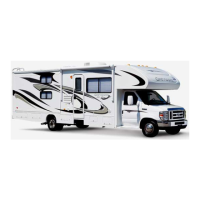
